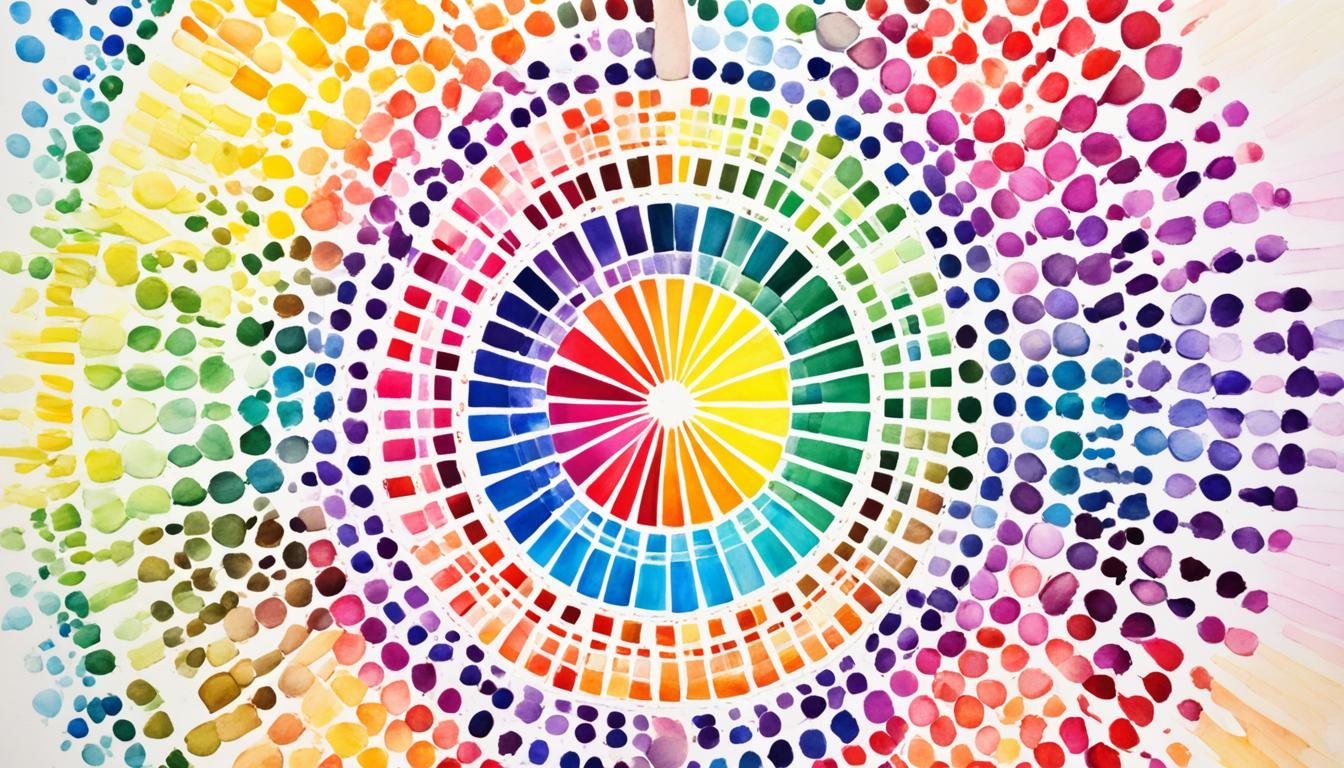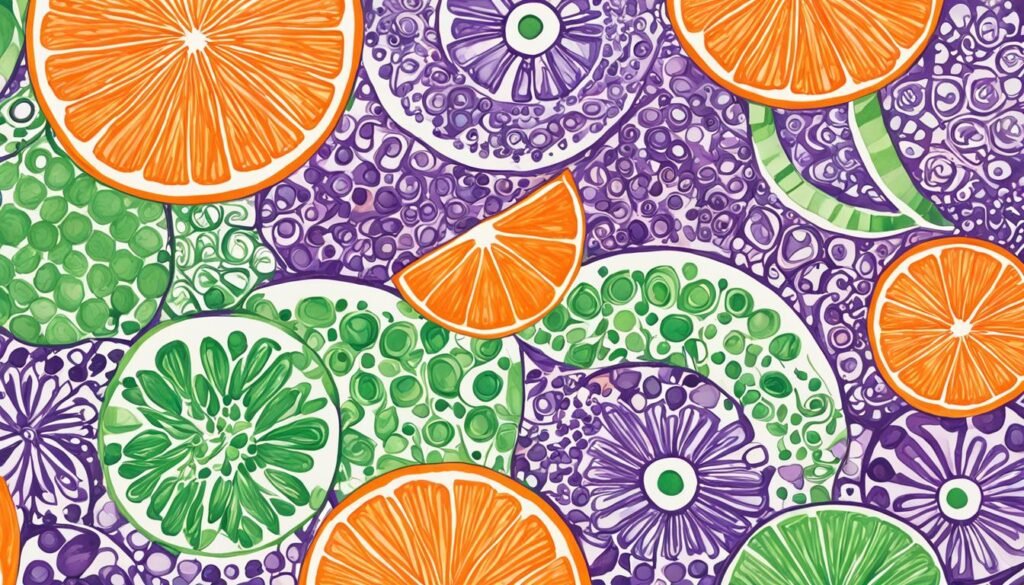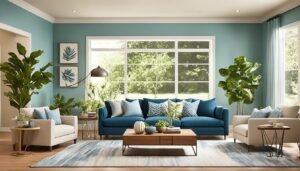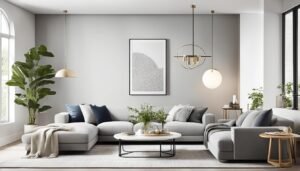
The 60-30-10 rule is key in interior decorating. This rule says to use 60% main color, 30% secondary color, and 10% accent color. It ensures balance and harmony in your designs and highlights the importance of color choice.
There are more rules and schemes than just 60-30-10. You can use analogous colors (neighbors on the wheel) or complementary colors (opposites) for different effects. Monochromatic schemes focus on shades of one color. Even a 110% option exists for those wanting more color. It includes two accent colors alongside the 60-30-10 model.
Key Takeaways
- The 60-30-10 rule guides color distribution for pleasing spaces.
- Color scheme choices, such as analogous or complementary, set different vibes.
- Understanding color theory is crucial for good design.
- Start with neutrals and add bright colors to liven up a room.
- Personal style and alternative approaches can lead to attractive spaces.
Understanding the Color Wheel
The color wheel is key to understanding color theory in interior design. It includes 12 hues, mixing three primary, three secondary, and six tertiary colors. Knowing how these colors mix helps in creating beautiful color schemes for your home.
Primary Colors: Red, Blue, and Yellow
Primary colors are the basis of the color wheel. They are red, blue, and yellow. You can’t make these colors by mixing any others. Every other color comes from them.

When you mix two primaries, you get the secondary colors: orange, green, and purple. Mix red and yellow to get orange. Mix blue and yellow to get green, and blue and red to make purple.
Then, you have the tertiary colors. These mix a primary with an adjacent secondary. The six tertiary colors are red-orange, yellow-orange, yellow-green, blue-green, blue-violet, and red-violet.
| Primary Colors | Secondary Colors | Tertiary Colors |
|---|---|---|
| Red, Blue, Yellow | Orange, Green, Purple | Red-Orange, Yellow-Orange, Yellow-Green, Blue-Green, Blue-Violet, Red-Violet |
It’s vital to know how primary, secondary, and tertiary colors work together. This knowledge is essential for making your design projects look great and feel balanced.
Secondary Colors: Orange, Green, and Purple
On the color wheel, orange, green, and purple are known as secondary colors. They come from mixing two primary colors. These colors look great with primary ones. They’re also used to make tertiary colors more complex.
Colors next to each other on the wheel create a smooth and calming look. Complementary colors like orange and blue, or red and green, bring energy. Designers often use secondary colors to brighten up a room’s color mix.
Did you know, up to 90% of how we feel about a product can be just the color? The main colors are red, blue, and yellow. Next come secondary shades like orange and purple. Then there are mixtures like magenta or teal.

Warm colors make us feel lively and creative. Cool tones, on the other hand, bring tranquility. UI designers like the RGB model for screens. But CMYK, for printing, is better with more varied colors.
Now, there are more color options than ever before. We aren’t limited to just eight like in the past. Secondary colors are key for a good mix in both design and art.
Tertiary Colors: Combining Primary and Secondary Hues
In the color world, tertiary colors are key. They help make palettes stunningly beautiful. These colors come to life when mixing a primary color with a neighboring secondary on the wheel. For example, red-orange, yellow-green, and blue-violet are all tertiary colors.
Tertiary colors connect primary and secondary ones. They give designers more choices for a look that’s both subtle and engaging. Designers can blend these colors for a peaceful analogous color scheme. Or they can use them with complementary colors for a brighter, more dynamic look.
Knowing how to work with tertiary colors is vital in decorating spaces. They let designers add depth and excitement to colors. With these intermediate colors, a design can be both harmonious and eye-catching.
Designing a cozy room or a striking area? Knowing about Tertiary Colors, Color Combinations, and Color Theory is a must. It’s a skill all designers and color fans should have.
Color Guidelines for Decorating
Choosing the right color palette is key in interior design. It sets a mood and brings your space together. The 60-30-10 rule is a great guide. It advises using a main color for 60% of the room, another for 30%, and a bright accent for the last 10%. This method creates balance and interesting contrasts in your decor.
Designers often mix up the 60-30-10 rule. They might try a 70-20-10 or 50-30-20 split. It all depends on what look they’re going for. Knowing how the color wheel works helps. They pick colors that work well together, like shades close to each other or those directly across.
To get a look that flows well, think about what’s already in your room. Your furniture, art, and the structure of the space matter. Including them in your color plan helps make everything feel connected. Color tools online, like Coolors and Canva, can also be super helpful.
Warm and cool tones can work beautifully together. A mix of both adds layers to your design. Start with a neutral as your key color. Then, add warmer or cooler shades for depth. Playing with different color proportions helps you keep things interesting.
The 60-30-10 rule is just a tip. Feel free to change it to suit your style. Let your imagination loose when picking colors for your home.
Monochromatic Color Schemes
Monochromatic color schemes are perfect for a calm, unified space. They dive deep into one color, showing off different Tints, Shades, and Tones. This variety makes a room both striking and peaceful. It’s all about using Color Variations to make your space feel just right.
Variations Within a Single Hue
To make a monochromatic scheme work, designers use shades and tints well. They pick a main color and then mix in lighter or darker tones. This method brings life and balance to the room. It shows off what that color can really do.
Adding different textures and materials makes a monochromatic room even more interesting. Mixing smooth and rough materials, like wood and soft fabric, adds layers. It keeps the room from feeling too flat.
True designers love monochromatic schemes for their clarity and flow. They let the room’s structure and decor stand out without color clashes. It’s a clean canvas that highlights every corner beautifully.
Monochromatic design works for every color, from bold to soft. It’s a classic choice for any room. By playing with different tones of one color, designers bring balance, charm, and style into their spaces.
The Psychology of Color
Colors deeply affect how we feel and the vibe of a room. It’s key to know what emotions each color can provoke. This helps when you’re decorating or painting your place. You want to pick colors that will make people feel the way you intend.
Reds, oranges, and yellows bring a sense of life and energy. They can lift spirits and make a space feel vibrant. Meanwhile, blues, greens, and violets are calming. They make you feel peaceful and relaxed.
Greens remind us of nature and bring calm. Yellows are cheery and lively. Bold reds show passion and courage. While soft pinks feel gentle and sweet. When you’re picking colors for a room, think about the mood you want to create.
It’s a good idea to mix warm and cool colors for balance. This mix can make a space look welcoming. It also meets the different feelings people might want in that area.
“Colors have the power to evoke specific emotional responses and create different moods within a space.”
Knowing about Color Psychology, Emotional Responses, and Mood helps a lot. Whether it’s Warm Colors or Cool Colors, making smart choices is important. This way, you decorate your place to achieve the mood you desire.
Conclusion
Knowing color theory is key to making beautiful and balanced interior design. You’ll understand which colors go well together by using the color wheel. This knowledge lets designers and homeowners pick the right colors for their rooms. It also helps create a certain mood or feel in a space.
By following color guidelines and trying different things, you can improve your home’s look. Learning about color schemes and their meanings lets you design wisely. This way, you can make rooms that look good and help guests feel a certain way.
Mastering color theory in interior design is exciting and can truly change your space. Mix and match colors, experiment, and let your style stand out. This way, you’ll make spaces that are uniquely you and that you enjoy.
FAQ
What is the color wheel and how can it help with decorating?
What are the primary, secondary, and tertiary colors on the color wheel?
How can I use the 60-30-10 color rule in interior design?
What are the benefits of a monochromatic color scheme?
How do warm and cool colors affect the mood of a room?
Source Links
- https://www.thespruce.com/timeless-color-rule-797859
- https://www.bhg.com/decorating/color/basics/color-wheel-color-chart/
- https://witanddelight.com/2020/07/a-color-skeptics-guide-to-color-theory-in-design/
- https://blog.hubspot.com/marketing/color-theory-design
- https://homemadelovely.com/how-to-use-a-color-wheel-for-decorating/
- https://www.settingforfour.com/understand-color-wheel-color-schemes-become-a-better-decorator/
- https://careerfoundry.com/en/blog/ui-design/introduction-to-color-theory-and-color-palettes/
- https://www.interaction-design.org/literature/article/complementary-colors-and-color-wheel
- https://www.rockmyspace.com/design-blog/color-wheel-guide
- https://online.maryville.edu/liberal-arts-degrees/the-art-of-color/
- https://www.flux-academy.com/blog/how-to-strategically-use-color-in-website-design
- https://foyr.com/learn/color-theory-in-interior-design/
- https://thegempicker.com/interior-color-palette/
- https://www.spacejoy.com/interior-designs-blog/how-to-pick-color-palette
- https://www.elledecor.com/design-decorate/color/g26629581/best-color-combinations/
- https://www.thespruce.com/what-is-a-monochromatic-color-scheme-1973826
- https://www.elledecor.com/design-decorate/color/advice/a7969/monochromatic-color-scheme-how-to/
- https://www.housebeautiful.com/room-decorating/colors/g28777092/monochromatic-color-schemes/
- https://foyr.com/learn/psychology-of-colors-in-interior-design/
- https://www.fromhousetohome.com/room-color-psychology/
- https://www.truevalue.com/diy-projects/paint-and-stain/choosing-home-color-schemes/
- https://www.deesignre.com/how-to-choose-and-combine-colors/
- https://www.nngroup.com/articles/color-enhance-design/
- https://diyhomecomfort.com/blog/using-color-theory-for-interior-design






No comment yet, add your voice below!